A First Look at Thunderbolt on Windows with MSI's Z77A-GD80
by Anand Lal Shimpi on May 11, 2012 1:32 PM EST- Posted in
- Motherboards
- CPUs
- Intel
- MSI
- Thunderbolt
Update: Intel has informed us that we will see updated drivers for Windows certified Thunderbolt devices that will enable hot plugging under Windows as well as address some of the behavior we've seen. Intel further informed us that MSI's board has not yet made it through the certification process and a lot of these teething issues will hopefully be addressed by then.
I finally made the transition to a notebook as my desktop last year, a move many had made years prior. Quad-core mobile Sandy Bridge and good SSDs made the move simple for me, but Thunderbolt eventually made it near perfect. With only two drive bays in my notebook (I ditched my optical drive so I could have another SSD, something Brian Klug did back in 2010), there wasn't any room for good, high-performance, mass storage. Thunderbolt solved this problem for me.
Co-developed by Apple and Intel, Thunderbolt is a tunnel that carries both PCIe and DisplayPort traffic to the tune of 20Gbps per channel (10Gbps up and down). In the past, whenever you wanted to add a PCIe device (LAN, audio, high-speed storage, etc...) you needed to physically install that device in your system either via an ExpressCard slot on a notebook or via a PCIe slot on your desktop. Thunderbolt acts as a decoupler for PCIe devices, allowing you to put controllers that would traditionally lie inside your system outside of it, or even inside another device like a display. That's where the DisplayPort support comes in.
Apple's Thunderbolt Display is the perfect example of what Thunderbolt can be used to do. Take a DisplayPort panel, integrate Gigabit Ethernet, Firewire 800, audio and USB controllers and you've got Apple's Thunderbolt Display. In theory, you could connect a system that had none of these things, and the functionality would be provided exclusively by the display. Decoupling hardware like this allows OEMs to build thinner and/or smaller form factor machines (think Ultrabooks/MacBook Air), while allowing for full functionality when connected to a display. By carrying DisplayPort over the same cable, you can have a single cable that both extends functionality and connects your small form factor machine to a larger monitor. Thunderbolt enables the modern day dock for notebooks.
For all of last year, Thunderbolt was an Apple exclusive. This year, starting with the launch of Ivy Bridge, Thunderbolt is coming to PCs. We'll see it on notebooks as well as some desktop motherboards. Today we have the very first desktop motherboard with Thunderbolt support: MSI's Z77A-GD80.
Don't expect ubiquitous deployment of Thunderbolt, especially not on desktops, as the Thunderbolt controller and associated components add cost where margins are already very thin. Instead you can expect higher end motherboards to integrate it, or offer an add-in card of sorts which is the route ASUS is taking. I'd expect Ultrabooks to make better use of Thunderbolt naturally, but we will see it on desktops this year.
The Z77A-GD80 is a very full featured ATX Z77 motherboard. You get three physical PCIe x16 slots, although they are only supported in the following configurations:
| MSI Z77A-GD80 PCIe x16 Supported Configurations | ||||
| Ivy Bridge | Sandy Bridge | |||
| PCIe x16/0/0 | 1 x16 | 1 x16 | ||
| PCIe x8/8/0 | 2 x8 | 2 x8 | ||
| PCIe x8/4/4 | 1 x8 + 2 x4 | Not Supported | ||
Both CrossFire and SLI are supported.
You'll find a standard eight SATA ports on the motherboard (4 x 6Gbps, 4 x 3Gbps, 6 driven by Intel's controller). USB 3.0 comes native thanks to Intel's Z77 chipset, with two ports on the rear IO panel as well as a header and a supplied bracket for two more ports. Intel LAN comes standard as well. Audio is driven by a Realtek ALC898 controller, while VIA's VT6315N powers the on-board Firewire header.
The Star of the Show: Thunderbolt
The big news is of course the Thunderbolt port on the IO panel. Counting it, there are a total of three display outputs on the GD80, the other two are VGA and HDMI.
I believe the Thunderbolt controller on the GD80 is this little chip on the board, just behind the analog audio outputs on the IO panel. It also looks like the controller branches off of the Z77 PCH's PCIe 2.0 lanes. Although there are four PCIe x1 slots on the board, you can only use two at a time - likely because of the way the Thunderbolt controller connects to the system as it uses 4 of the 8 available PCIe 2.0 lanes. The remaining lanes aren't enough to support the on-board LAN, Firewire, audio and SATA controllers in addition to the extra PCIe slots and Thunderbolt. As a result there are limitations on what you can use in parallel (e.g. you can't use Firewire and SATA ports 7/8) in order to deal with the PCIe overprovisioning.
The markings on the Thunderbolt controller aren't familiar, so it could very well be that we're looking at Cactus Ridge - Intel's 2012 Thunderbolt controller we first heard about last year. Cactus Ridge doesn't change performance, it just helps reduce cost by integrating more functionality into the controller itself.
The beauty of Thunderbolt is it's near invisible to the OS. You don't need to install any drivers to take advantage of it, just plug your devices in and as long as your devices have driver support they'll just appear. The OS has no idea that your SATA, Ethernet or RAID controllers are sitting a few feet outside of your box, they all appear as normal PCIe devices.
As we found in our initial review of Thunderbolt on the MacBook Pro, Windows does not allow for the hot plugging of Thunderbolt devices. You can remove a Thunderbolt device once in Windows, but you cannot add a new one. Anything you want access to in Windows has to be plugged in at boot. OS X allows more flexibility in this regard as you can add/remove Thunderbolt storage and other devices while the OS is running, but even then it's not always well behaved. It's not all that uncommon to need a reboot after plugging in a chain of Thunderbolt devices under OS X, although admittedly Apple has been improving compatibility and behavior over time.
Update: Intel has informed us that we will see updated drivers for Windows certified Thunderbolt devices that will enable hot plugging under Windows. Intel further informed us that MSI's board has not yet made it through the certification process and a lot of these teething issues will hopefully be addressed by then.


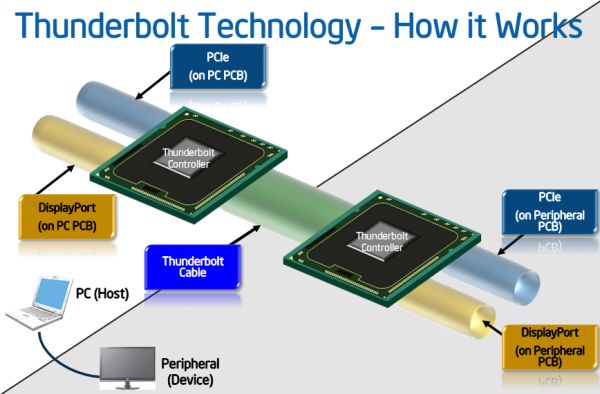

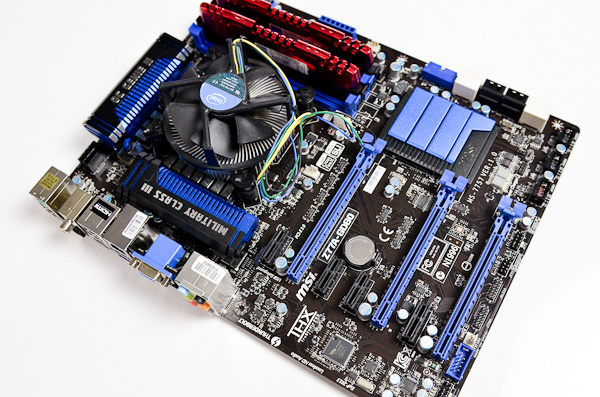






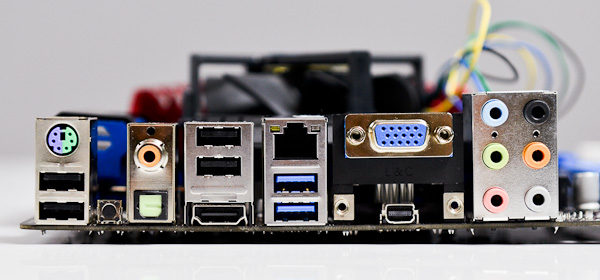
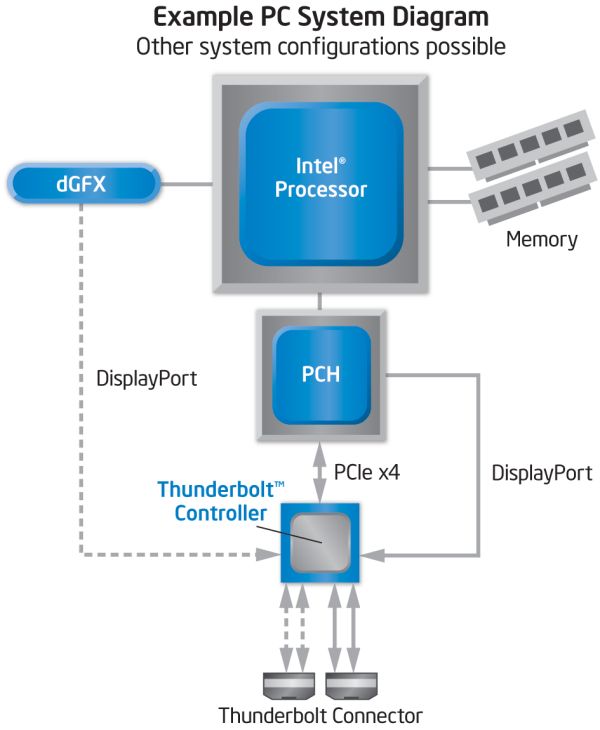
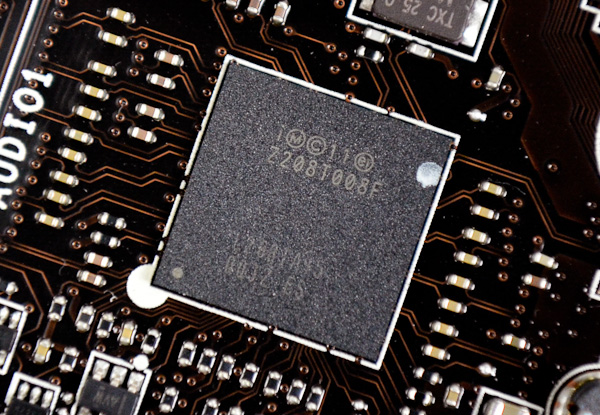








98 Comments
View All Comments
zanon - Friday, May 11, 2012 - link
Back during your CES 2012 coverage in January you reported on one of the initial planned external expansion boxes, the MSI GUS II. Things like that (I know there are a few others now) seem to be where the story gets truly interesting for mobile users IMO. Even though the bandwidth available is only equivalent to a few lanes, testing like HardOCP's 480 x16 vs x4 article indicates that at single screen resolutions (ie., no more then 2560x1600) graphics cards can perform shockingly well even with severely restricted bandwidth. So more then merely having a hub there's the potential of being able to plug an ultrabook into a hub and have a mid-range full GPU ready to go, along with a screen and other ports. If it all goes smoothly it could really expand the desirability of ultrabooks even farther, making them more and more no-compromise, although it'll probably take the next-gen 40/100 Gbps TB standard to push it farther or handle GPGPU applications. Still exciting stuff.Guspaz - Friday, May 11, 2012 - link
Sadly, the MSI GUS II is not that useful due to only supporting bus power (75W, no external power connectors supported). The fastest (nVidia) card it can support is the GT 640, which isn't that much faster than the integrated graphics it would be intended to replace. Anything faster can't be bus-powered.It would give you a small graphics upgrade over the Ivy Bridge integrated graphics, but not a big enough one to warrant all the cost and effort... and a notebook with discrete graphics could easily outperform it.
If they add support for externally powered GPUs (anything that draws over 75W), then it could be something special.
zanon - Friday, May 11, 2012 - link
That's extremely trivial though, I was only using it as an Anandtech featured example of one initial expansion, not as the ideal solution itself. Not exactly a big deal to stick a tiny external power source in there, in fact it's odd MSI didn't do it in the first place (or who knows, maybe it'll get revised before release), but as the chips themselves become cheaper and get plenty of supply it seems likely other solutions will appear. It feels like one of the real possible killer apps for the interface after all, something that can't be easily replicated through other means.
DerPuppy - Friday, May 11, 2012 - link
they are (villagetronic+others in the egpu community) working on a thunderbolt system..supposedly development support is limited to large partners though because the thunderbolt team at intel is overworked? someday it'll come out, external gpu solutions on >x1 PCIe2.0 connections, that is. the power issue is somewhat of a nonissue if you don't mind bringing around any sort of 12v psu, be it normal atx, sfx, or w/e and just hooking it upRoland00Address - Friday, May 11, 2012 - link
The product tag says the device can support up to 150w cards. See product tag picture here.http://www.eteknix.com/wp-content/uploads/2012/01/...
I also have heard it has been reported there is no 6 pin power thus the device can only do 75w.
If the device can do 150w you can put a 7850 in there, or possibly a gtx 660 (the gtx660 is a personal guess since the gtx 670 tdp was 170w and to do the gpu boost on the gtx 670 the tdp has to be 141w.)
yyrkoon - Saturday, May 12, 2012 - link
Thing is though, even more important than power. Is the technology bandwidth.10 Gbps (one-direction ) really is not that much in the way of graphics card bandwidth. As I recall. a 7600GT from a few years back, could chew through about 20Gbyte /s under intensive situations. So 10 Gbit/s is hardly going to put a dent into that. So with that in mind, we're basically stuck with integrated graphics performance again.
That is, at least until the next iteration of the technology. Maybe.
Still, from a modular system approach, I like the idea. However I doubt it would be practical any time soon ( like you pretty much already said ).
DerPuppy - Saturday, May 12, 2012 - link
No idea where you're getting these metrics from? PCIe 3.0 x16 is 16GB/s so there's no way a 7600GT could have used that much bandwidth. maybe you're referring to the internal memory bandwidth?? It has been proven that an x4 2.0 connection is sufficient for about ~80-90% of the performance of an x16 link in many gaming situationsyyrkoon - Sunday, May 13, 2012 - link
Of course it was the memory bandwidth." It has been proven that an x4 2.0 connection is sufficient for about ~80-90% of the performance of an x16 link in many gaming situations"
You would be very lucky to see half that. It is very likely, that you would see 25% or less of that.
People have been working on this problem for years now. Through other means. Partially, they have succeeded, using the MXM laptop graphics connection. At a cost that begs to wonder why they did not just buy a $2000 laptop to begin with.
You can buy an external graphics enclosure, for laptops, right now. If you're willing to spend ~$800 for it. Then, only if you have the right laptop.
So in ending I will say this. You're dreaming. You're dreaming a dream I have had myself. At some point however, you're going to have to come back to reality.
Oh, one last thing. I should point out that Gigabytes, and Gigabits are not universal with one another. 10 Gigabit == 1.25 Gigabyte. That is, 25% more, than a PCIe 1x 1.0 connection can handle. Under ideal circumstances.
How do you like them metrics ?
repoman27 - Sunday, May 13, 2012 - link
Well, connecting a GPU via Thunderbolt doesn't affect the memory bandwidth, so that's not really relevant.Plus your math is way off. A single Thunderbolt controller can provide 10 Gbps of PCIe bandwidth. A PCIe 1.0 x1 connection provides 250 MB/s (i.e. 2 Gbps) which is 1/5 of what you get from Thunderbolt. Or put another way, Thunderbolt can currently provide the equivalent of a PCIe 2.0 x2.5 connection.
DerPuppy is correct. If driver support with PCIe compression for Thunderbolt connected GPU's was available, we could achieve better than 80% of the real-world performance of a PCIe 3.0 x16 connected GPU with an external solution.
Note the x2 (2 GB/s) performance in these charts: http://www.anandtech.com/show/5458/the-radeon-hd-7...
Jaybus - Monday, May 14, 2012 - link
Yes, more bandwidth is needed to support external high end GPUs, not to mention the simultaneous use of multiple external PCIe devices. This is why the initial Intel project was named Light Peak. Intel Labs silicon photonics researchers never intended the interface to use an electronic PHY. I believe the electronic PHY version (Thunderbolt) was due to Apple's collaboration along with Intel hitting snags in the development of an on-chip optical PHY.. Ultimately, there will be an optical PHY, since the ability to scale the electronic PHY is limited.